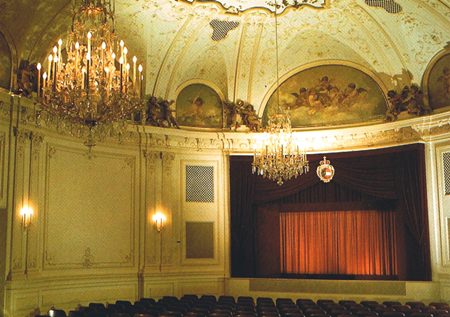If you are over a certain age, you may recall this song from the Swinging Sixties. It was made famous by Sandy Shaw after winning the Eurovision Song Contest in 1967, remaining at the top of the British pop music charts for three weeks. Sandy Shaw (whose real name was Sandra Ann Goodrich) evidently loathed it and once said that she “hated it from the very first oom-pah to the final bang on the bass drum.” She was “instinctively repelled by its sexist drivel and cuckoo-clock tune.”
Incidentally, in 1964 Elvis Presley recorded a song also called Puppet on a String, but it was a syrupy mawkish ballad with breathtakingly vapid lyrics that could have been written by a horse. The other day, I was amazed to discover that the Eurovision Song Contest is still going strong since its first airing in 1956.
 Salzburg Marionette Theatre.
Salzburg Marionette Theatre.
The art of making and manipulating puppets probably originated at least three or four thousand years ago in what is now India. It’s thought that puppetry eventually appeared in almost all human societies both as a form of entertainment and as a form of ritual. The early Christian church used puppets to perform morality plays and gave us the word marionette (meaning “little Mary”) referring to the tiny models of the Virgin Mary used in the plays. During the eighteenth century puppetry flourished all over Europe and the technology developed too. Marionettes eventually had up to eight strings to allow a wide range of movements.
At the same time, marionette operas became popular and Haydn wrote about half a dozen specifically for the Royal Marionette Theatre when he was in the employment of the fabulously wealthy Prince Esterhazy. Today, there are marionette theatres in several European cities but the Salzburg Marionette Theatre is one of the best-known. Founded in 1913, it’s one of the oldest continuing marionette theatres in the world and performs a large repertoire of operas, ballets and other productions for both children and adults.
Wolfgang Amadeus Mozart (1756-1791): Le Nozze di Figaro (The Marriage of Figaro) Salzburg Marionette Theatre. Various soloists, London Philharmonic Orchestra cond. Carlo Maria Guilini (Duration: 01:52:56; Video 360p)
This a complete performance of Mozart’s popular comic opera which was first performed at the Burgtheater in Vienna in 1786. Mozart himself directed the performance from the keyboard, as was the custom in those days. It was well-received by the Viennese audience and it ran for nine performances, but this pales in comparison with The Magic Flute which ran every other day for several months.
The fascinating marionette performance in this video uses Guilini’s well-known 1950s recording and the scenes are introduced by Sir Peter Ustinov, who brings his own brand of insight and humour to explain the convoluted plot. In this performance marionettes play the roles of humans, but in Stravinsky’s Petrushka the situation is reversed with ballet dancers playing the roles of puppets.
Igor Stravinsky (1882-1971): Petrushka (original 1911 version). National Youth Orchestra of Great Britain cond. Edward Gardner (Duration: 34:19; Video: 720p HD)
Stravinsky achieved international recognition with three ballets commissioned by the Russian impresario Sergei Diaghilev. They were premiered in Paris by Diaghilev’s own company, Ballets Russes. In an incredible frenzy of creative activity, The Firebird appeared in 1910, Petrushka in 1911 and The Rite of Spring in 1913. This work was so ahead of its time that it caused a near-riot at the first performance, but it was to become the most influential orchestral work of the twentieth century.
The composer had originally conceived Petrushka for the concert hall but Diaghilev immediately realized its theatrical potential as a ballet. Petrushka is a rather charmless folk character who has been around for a good many years. He may have had his origins in the Italian masked comedies of the sixteenth century in which he was known as Pulcinella. In Great Britain he was transformed from a marionette to a hand-puppet called Punch, the villain of traditional Punch and Judy shows.
The ballet tells the story of the loves and jealousies of three puppets magically brought to life by a showman during the Shrovetide Fair in Saint Petersburg. At the first performance, the title role was danced by the great Vaslav Nijinsky and the performance conducted by Pierre Monteux.
One of the interesting musical devices that Stravinsky used has become known as the Petrushka chord and it’s employed to announce the appearance of Petrushka himself. It consists of the chords C major and F sharp major played together which harmonically is about as far as two chords can be from one another. Perhaps this might sound a bit daunting but actually the music is tuneful and approachable, full of lively rhythms and of course, it sizzles with Stravinsky’s brilliant orchestration.
This performance was recorded last year at the Proms and these young British musicians give a thrilling account of the colourful work.




